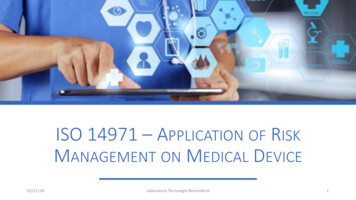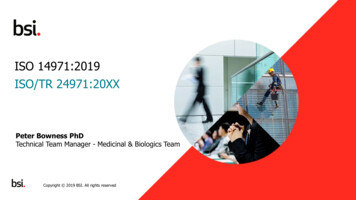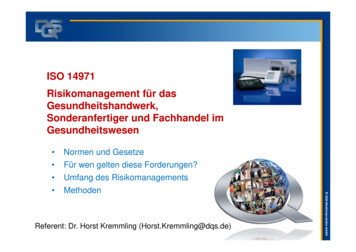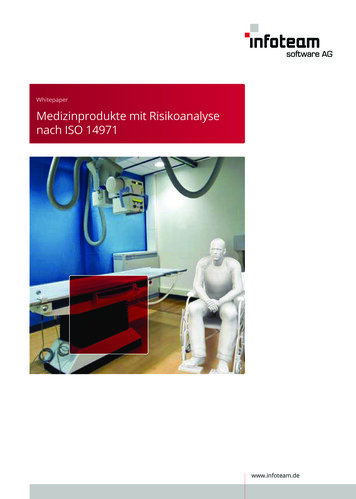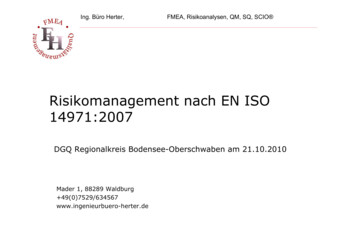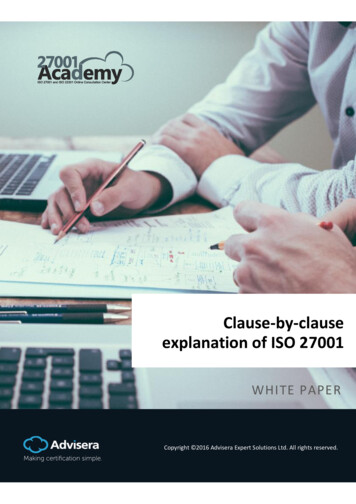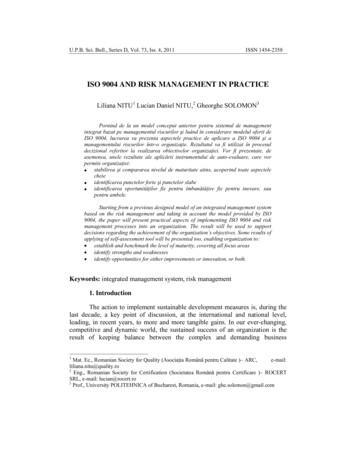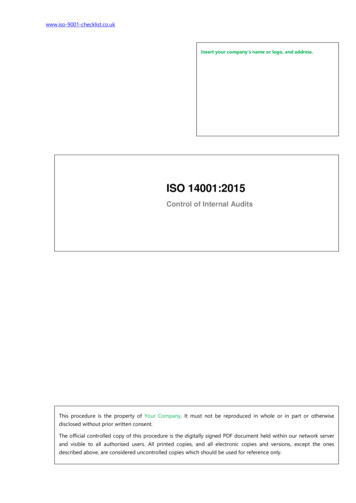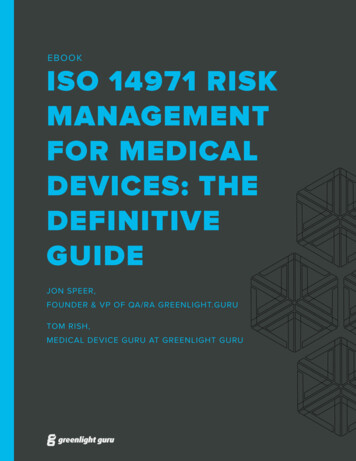
Transcription
E B O OKISO 14971 RISKMANAGEMENTFOR MEDICALDEVICES: THEDEFINITIVEGUIDEJON SPEER,FOUNDER & VP OF QA/RA GREENLIGHT.GURUTOM RISH,MEDICAL DEVICE GURU AT GREENLIGHT GURU
ISO 14971 RISK MANAGEMENT FOR MEDICAL DEVICES: THE DEFINITIVE GUIDEPAGE 1ISO 14971 RISKMANAGEMENT FORMEDICAL DEVICES: THEDEFINITIVE GUIDETABL E O F CONTENTS02 WHAT IS RISK03 THE IMPORTANCE OF RISK ANDMEDICAL DEVICES04 INTRODUCTION TO THEDEFINITIVE GUIDE TO ISO 14971RISK MANAGEMENT FOR MEDICALDEVICES04 WHAT YOU WILL GAIN FROM THISGUIDE TO ISO 149711322 RISK ASSESSMENT RISK ANALYSIS RISK EVALUATION22 RISK ANALYSIS24 IDENTIFICATION OF HAZARDS31RISK CONTROLS31RISK REDUCTION32 RISK CONTROL OPTION ANALYSIS06 REGULATIONS & STANDARDS FOR ISO14971 RISK MANAGEMENT33 IMPLEMENTING RISK CONTROLS07 ISO 14971 – THE CURRENT STATE34 BENEFIT-RISK ANALYSIS10 DESIGN CONTROLS & RISKMANAGEMENT35 RISKS FROM RISK CONTROLSRISK MANAGEMENT PROCESSOVERVIEW15 RISK MANAGEMENT DEFINITIONSYOU NEED TO UNDERSTAND1720 RISK MANAGEMENT FILEROLE OF MANAGEMENT IN RISKMANAGEMENT19 RISK MANAGEMENT PLANWWW.GREENLIGHT.GURU33 RESIDUAL RISK EVALUATION35 OVERALL RESIDUAL RISKACCEPTABILITY36 RISK MANAGEMENT REVIEW37 PRODUCTION & POST-PRODUCTIONINFORMATION38 SUMMARY
ISO 14971 RISK MANAGEMENT FOR MEDICAL DEVICES: THE DEFINITIVE GUIDEPAGE 2WHAT IS RISKTake a moment and think about this: What is RISK? How does RISK impact you every day?The #1 definition in the dictionary defines RISK as possibility of loss or injury.There are things that each of us do every day that involves RISK.The food you eat, the habits you have, your daily routine – all full of risks in someway, shape, or form.One of the riskiest things I do just about every single day is drive my car.But I don’t usually think about this being a risk at all. I take it for granted.Could I get in an accident? Could I get injured or possibly die? Of course. Yet Iestimate that the likelihood of these things happening to me are low enough thatI willing get behind the wheel without question.Maybe it’s because I know that my car has anti-lock brakes, seat belts, and airbags.Maybe it’s because I know that the car I drive has been through rigorous safety testing.Risk per ISO 14971 is defined as the combination of the probability of occurrenceof harm and the severity of that harm.The intent behind Risk Management is to identify, evaluate, analyze, assess, andmitigate potential product issues.Risk Management is a total product life-cycle process.
ISO 14971 RISK MANAGEMENT FOR MEDICAL DEVICES: THE DEFINITIVE GUIDEPAGE 3THE IMPORTANCE OF RISK AND MEDICAL DEVICESI remember the first day on the job as a medical device product developmentengineer. During the orientation, I was shown a company video that includedemployees throughout the organization.Every person shown on the video talked about a common theme: realizing thatthe medical devices they were part of bringing to market could someday be usedon a friend, family member, and possibly themselves.It started to hit me. The gravity and importance of the job I was about to start.Medical devices that I designed and developed could be used on my mom,sister, kids, and so on.Imagine this from the perspective of a patient going in for any medicalprocedure. The patient probably thinks very little about the risks of the medicaldevices about to be used.Generally, the patient trusts the expertise of the clinicians. The patient seldomwonders if the products used by the clinicians are safe and have beenthoroughly and rigorously tested.The patient, often unknowingly, accepts the risks of the medical device you and Idesign, develop, and manufacture.And this is exactly why Risk Management is so important to the medical device industry.You have to know that the medical devices you are involved with bringing topatients and end-users are safe.WWW.GREENLIGHT.GURU
ISO 14971 RISK MANAGEMENT FOR MEDICAL DEVICES: THE DEFINITIVE GUIDEPAGE 4INTRODUCTION TO THE DEFINITIVE GUIDE TO ISO 14971 RISKMANAGEMENT FOR MEDICALDEVICESMy entry into the medical device industry was not a planned career path. Withinthe first few months of starting as a product development engineer, I knew that Iwould spend the rest of my life involved with the medical device industry.Why?Because I knew then, as I do now, that I have a positive impact on the quality of life.Products that I have helped design, develop, and bring to market have improvedthe quality of life for thousands and thousands of people. And today, I amfortunate to have an opportunity to work with many others who have the samepurpose and mission.If you think about it, the ideal of improving the quality of life is the very premiseof product risk management.WHAT YOU WILL GAIN FROM THIS GUIDE TO ISO 14971The topic of Risk Management is one that can be daunting, and at timesconfusing. Thankfully, ISO 14971 exists and is helpful in providing guidance anddirection.
ISO 14971 RISK MANAGEMENT FOR MEDICAL DEVICES: THE DEFINITIVE GUIDEPAGE 5ISO 14971 provides a thorough explanation of relevant terms and definitions. Andthe standard defines a risk management process.I’ve written this guide to align with the latest version of ISO 14971 and to provideyou additional tips and insights for medical device risk management.For me, it is very interesting to observe and listen to feedback and commentsabout the topic from the perspectives of the experts, the regulators, theconsultants, and medical device companies.Many times, it seems as though each of these perspectives has a very differentview of the world regarding medical device Risk Management. At times, it seemsas though no one agrees.The practice of Risk Management in the medical device industry is also intriguingto me. By and large, what I have observed is that Risk Management is too oftensomething we do because we have to – a checkbox activity.It seems that we seldom use Risk Management as a tool to help us design,develop, and manufacture safer medical devices.But we should.1. The purpose of this guide is three-fold:2. To leave you with an understanding of what is expected from medicaldevice regulators regarding Risk Management.3. To help you use Risk Management as a tool to design safer medicaldevices by providing a few helpful tips and pointers to guide you.WWW.GREENLIGHT.GURU
ISO 14971 RISK MANAGEMENT FOR MEDICAL DEVICES: THE DEFINITIVE GUIDEPAGE 64. To share with you all the steps that you need to define and addresswithin your Risk Management procedures.Please note that the focus of this guide is strictly medical device product riskmanagement. I will not explore other “risk management” topics such as businessor project.REGULATIONS & STANDARDS FOR ISO 14971 RISKMANAGEMENTRealize that nearly every medical device regulatory agency has placed the topicof Risk Management front and center.In fact, regulatory agencies, including FDA, are now using risk-based processesthroughout their own internal processes when reviewing device submissions andconducting inspections and audits.KNOW THIS: U.S. FDA, Health Canada, EU Competent Authority, Australia TGA,and Japan MHLW all require you to have a Risk Management process definedand Risk Management documentation for your products.And all these regulatory agencies endorse ISO 14971 Medical devices —Application of Risk Management to Medical Devices.In addition to ISO 14971, there are several other key medical device industrystandards requiring risk management. The partial list includes:
ISO 14971 RISK MANAGEMENT FOR MEDICAL DEVICES: THE DEFINITIVE GUIDEPAGE 7 IEC 60601 IEC 62366 ISO 10993 ISO 13485Yes, all these standards make reference to risk management (and ISO 14971).Did you notice ISO 13485 is on that list?This is significant because the ISO 13485 standard is specific to qualitymanagement systems.The expectation is that you manage risk throughout the entire product lifecycleand throughout your entire QMS.ISO 14971 – THE CURRENT STATEI could share with you a history lesson on the genesis and evolution of medicaldevice risk management.While there may be some merit in going through this history, I suspect you areprobably more interested in the present state of Risk Management, as well aswhere things are headed.The current “state of the art” regarding risk management is described in the standardISO 14971 Medical devices – Application of Risk Management to Medical Devices.WWW.GREENLIGHT.GURU
ISO 14971 RISK MANAGEMENT FOR MEDICAL DEVICES: THE DEFINITIVE GUIDEPAGE 8A Brief Overview of the Standard and its Accompanying GuidanceDocumentThe current version of ISO 14971 was released in December 2019. This versionreplaced the previous two versions of the standard that were utilized by many ofyou across the world:ISO 14971:2007 and EN ISO 14971:2012As you likely know, the EN version was applicable if you were selling medicaldevices in Europe. While there is still an EN version of ISO 14971:2019, it isnow identical to the regular version of ISO 14971:2019. When selling in Europethough, it is important to know that additional risk requirements apply, which areoutlined in the EU MDR.Here is the abstract describing the standard:“This document specifies terminology, principles and a process forrisk management of medical devices, including software as a medicaldevice and in vitro diagnostic medical devices. The process describedin this document intends to assist manufacturers of medical devices toidentify the hazards associated with the medical device, to estimate andevaluate the associated risks, to control these risks, and to monitor theeffectiveness of the controls.The requirements of this document are applicable to all phases of thelife cycle of a medical device. The process described in this documentapplies to risks associated with a medical device, such as risks related
ISO 14971 RISK MANAGEMENT FOR MEDICAL DEVICES: THE DEFINITIVE GUIDEPAGE 9to biocompatibility, data and systems security, electricity, moving parts,radiation, and usability.The process described in this document can also be applied to productsthat are not necessarily medical devices in some jurisdictions and can alsobe used by others involved in the medical device life cycle.This document does not apply to:— decisions on the use of a medical device in the context of anyparticular clinical procedure; or— business risk management.This document requires manufacturers to establish objective criteria forrisk acceptability but does not specify acceptable risk levels.Risk management can be an integral part of a quality managementsystem. However, this document does not require the manufacturerto have a quality management system in place.”ISO 14971 is a very good standard. While not prescriptive per se, the standarddoes a very good job of explaining the requirements, expectations, and stagesof a risk management process.Additionally, the standard provides several informative annexes which providemore in-depth explanations and examples.WWW.GREENLIGHT.GURU
ISO 14971 RISK MANAGEMENT FOR MEDICAL DEVICES: THE DEFINITIVE GUIDEPAGE 10While this guide provides an overview, walk-through, and practical applicationof ISO 14971, I highly recommend that you do make 200 decision to actuallypurchase the standard (no, I don’t get a commission). It is worth it.The medical device regulatory world has adopted this standard. And I see noreason to abandon this notion.You should also be aware of ISO/TR 24971 – Guidance on the application ofISO 14971. 24971 (no, it’s not a typo) is a guidance document specifically for ISO14971. If you are seeking additional insights and guidance on application of ISO14971, the ISO/TR 24971 guidance is helpful.DESIGN CONTROLS & RISK MANAGEMENTDesign Controls are intended to demonstrate that a medical device has been:1. Designed to address the needs of users and patients.2. Designed to meet inputs and requirements.3. Proven to meet applicable standards.4. Meets performance criteria.Your Design Controls will prove that your medical device is safe for use.Does this sound like Risk Management?
ISO 14971 RISK MANAGEMENT FOR MEDICAL DEVICES: THE DEFINITIVE GUIDEThe intent behind Risk Management is to identify, evaluate, analyze, assess, andmitigate potential product issues.There is a very strong correlation and relationship between Design Controls andRisk Management.With Design Controls, you also identify, evaluate, analyze, assess, and mitigatepotential product issues.Design Controls and Risk Management address design, development, andmanufacturing of medical devices from slightly different perspectives.Good Design Controls Reduce Product RisksIf you are thorough with defining and documenting User Needs, Design Inputs,Design Outputs, Design Verification, Design Validation, and Design Reviews,then you will be on the right track towards ensuring your medical device is safe.Prior to clinical use, you have to know without a doubt that the product is safeand/or determine that the medical benefits outweigh the risks (which should bedocumented in a benefit-risk analysis).Embrace this in your own medical device product development efforts.Realize Design Controls and Risk Management are related.Realize that your overall goal in medical device product development andmanufacturing is to prove and demonstrate that your product meets clinicalneeds, design inputs and requirements, and is safe and effective.WWW.GREENLIGHT.GURUPAGE 11
ISO 14971 RISK MANAGEMENT FOR MEDICAL DEVICES: THE DEFINITIVE GUIDEPAGE 12Risk Management Is Still Needed Even With Good Design ControlsHaving solid Design Controls in place is NOT a substitute for Risk Management.Both are needed.Realize that Risk Management is just as important (maybe more so) than DesignControls.Realize that Risk Management is a way to evaluate your product from a differentperspective.Realize that good Risk Management involves a series of tools, when usedproperly, will drastically improve the quality, safety, and effectiveness of yourmedical device.Risk Management & Design Controls Must
ebook iso 14971 risk management for medical devices: the definitive guide jon speer, founder & vp of qa/ra greenlight.guru tom rish, medical device guru at greenlight guru
